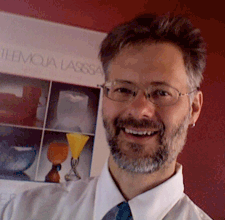Pilgrim Reindeer in Pisa, 1348
a free multimedia novel by
Thomas A. DuBois, University of Wisconsin-Madison
 |
Pilgrim Reindeer in Pisa, 1348 a free multimedia novel by Thomas A. DuBois, University of Wisconsin-Madison |
|
|
|
1. Part I Setting Out 6. Getting Doused [July 7, 1347]
In this chapter, I wanted to remind the reader that the front-line missionary character like Pekka might not always be the greatest font of accurate theological information. Pekka has his own limitations in his knowledge of Christianity, deriving from his apparent illiteracy and the remoteness of his own native Finnish culture from the Mediterranean world depicted in the Christian scriptures. Pekka sees no distinction between the word for Christ (in proper Finnish, Kristus), and the word for the cross: risti. Of course, etymologically, both words derive from the same Greco-Latin term borrowed into Finnish during the Christianization process, so Pekka's conflation of the two terms is really quite understandable.
Uncle, Aunt, and cousin Elle were important characters for the plot, because I needed to get Bávlos fit out for a long journey while keeping the spontaneity of his initial agreement to take Pekka to the next trading post. Here at his uncle's home, Bávlos can get everything he needs, and then some. Anyone who has done a long trek knows the crucial and difficult balance one needs to work out between the desire to bring along everything that will be needed and the desire to keep the pack light enough to carry. Aunt takes care of it all with a touch of the supernatural efficacy that one finds in Moominmamma's pocketbook or Hermione Grainger's enchanted bag. But there is no suggestion of magic here: just the good sense of a woman who has been making migratory treks all her life and who knows exactly what is likely to be needed. Wind knots had to be along as well, though, because they are a staple of lore about the Sámi from the medieval period, and they do indeed play a role later in the novel.
Of course, I also needed to get Nieiddash into the story, because, after all, this is the account of how the fresco in Pisa came to be, and the reindeer in it had to come from somewhere! In practice, she is a little young to be trained as a pack animal, and Sámi tended to use somewhat older geldings for this purpose. But you are not going to get much milk from a gelding.